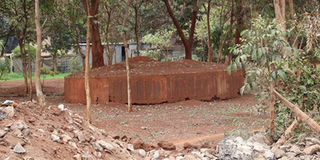The historic Mugumo tree that ‘marked the end of British rule’

The dilapidated site in Thika town where a mugumo tree once grew, on December 19, 2019. Historians say the tree carries cultural significance. PHOTO | CHARLES MUTURI
What you need to know:
- Historians say this was the place where Mugo, a Kikuyu seer, predicted the coming of white settlers.
- The reason Mugumo Garden was neglected is because it was at the heart of a colonial town and later an industrial town.
A 15-foot-long circular reinforcement is the only evidence that exists of the colonists’ attempt to protect Mugo wa Kibiru’s fig tree in Thika town.
Now a gazetted site, the Mugumo Garden had one of the largest fig trees in the country. Historians say this was the place where Mugo, a Kikuyu seer, predicted the coming of white settlers.
He had also predicted that the falling of a Mugumo would mark the end of British rule in Kenya.
Little is known about Mugo, whose original name was Cege wa Kibiru. He was nicknamed Mugo, meaning seer.
He would later inspire an entire generation after he warned about the invasion of the country by strangers.
While it was a place of worship by the Kikuyu community, the British decided to protect the Mugumo tree from falling and reinforced it with metal bars and a circular iron ring that was filled with soil.
It is said the British feared that if the tree fell, the Kikuyu would find a reason to start waging war and demanding freedom.
ECONOMIC MIGHT
The Kenya Colony was so important to the British since it was the gateway to the Uganda operations.
The British had built the Uganda railway through Kenya in order to tap the potential at the source of River Nile.
While Mugumo Garden is little known and hardly receives visitors, the only evidence of its importance was a visit by Mzee Jomo Kenyatta.
He visited the site in 1969 and planted a Mugumo tree to replace the one that had withered just as Kenya prepared for independence.
President Kenyatta had visited the town to open Thika Hospital – today’s Thika Level Five Hospital – and as part of his itinerary, he planted a commemoration tree at the old open-air market where the tree grew.
Although the National Museums of Kenya’s then director-general had on May 18, 2002 promised to renovate the garden, that did not pun out.
The fenced yard is always dusty or muddy depending on the season.
INDUSTRIES
Mugumo Gardens remains one of the few forgotten historical sites in Thika town. Others are the age-old tower clock opposite the nature garden, now known as Christina Wangari gardens.
The reason Mugumo Garden was neglected is because it was at the heart of a colonial town and later an industrial town.
The town once prided itself as the Birmingham of Kenya. Today, it hosts a number of factories – Del Monte, a food processing company; Bidco Oil Company; British American Tobacco; and the Kenya Vehicle Manufacturers, the only vehicle assembling plant in the country.
But amid all this, the town’s rich source of history has been forgotten and notably so is the Mugumo Gardens located at Section 9 of the sub-county.
So central was this giant fig tree that when the British missionaries arrived in Thika, they tried to convince Mugo to work with them but he turned them down.
PRESERVE CULTURE
As the country moved close to independence in 1963, the tree was struck by lightning and slowly withered away. Whether this had anything to do with Mugo’s prophesy, it is not clear.
As time fades, the real historical value of the gardens is more meaningful than it was yesterday.
As Richard Moe, the President of the National Trust for Historic Preservation (an NGO in the United States) once said: “Preservation is simply having the good sense to hold onto things that are well designed, that link us with our past in a meaningful way, and that have plenty of good use left in them.”
Is there a site you want us to feature? Write an e-mail to [email protected]




